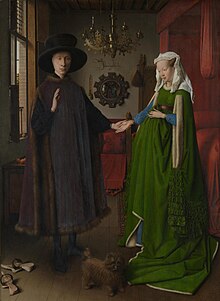Tappert (garment)
The Tappert (also Tapphart, Taphart, Tabard, Daphart, French tabard , Spanish tabardo , Italian tabarro ) is a skirt-like garment of the Middle Ages that was worn from the 13th century, but especially by men at the beginning of the 14th century when fashion shifted to cloth-rich robes. The robe is related to the tabard and tends to be closed at the front, although there may be short slits at the neckline. The Tappert is considered to be the predecessor of the Schaube , which increasingly replaced it as an open-front garment in the last quarter of the 15th century. Nevertheless, the Tappert was worn until the 16th century. A special example was the Spanish version, which was provided with a hood . The Tappert is identical to the Houppelande from France and Burgundy .
There were different variants in different forms that have a lot in common, but often also differ. Many different fabrics and valuable materials were also used in its manufacture.
Male form
In contrast to the women's coat called tabbard, the men's tapper had long arm overhangs. It was slit on the sides from the waist down to the knee. The edges were decorated with zaddles or often covered with plenty of fur, trimmed and lined.
The Tappert was worn in numerous variants, half-length and long, sleeveless and open at the sides, with wide arm slits or with sleeves of diverse, extensive shapes. The edges were almost always lined with fur, often not only the torso but also the sleeves were lined with fur, whether they hung loosely as open wings, were in the shape of a pouch or bag or, as in the advancing 15th century, were of even width. In the first half of the 15th century, the sleeve cuts, which essentially made up the fashionable change in tapper, changed, but the type of all-round fur trimming remained the same, it contributed significantly to the decorative effect together with rich or plain fabric. Marten skins were often used for higher quality coats, and feh , the fur of the gray / white Russian squirrel, was another common lining and trimming material. Marten throats or other pieces of fur as well as cheaper types of fur, for example fox fur, were used for less expensive parts . Sable and ermine fur were forbidden by dress codes not only to ordinary citizens, but also to barons and imperial barons.
Elegant fur-trimmed tappers were characteristic of the French-Dutch costume. The Duchy of Burgundy (1361–1477) was one of the most prosperous states and a cultural center and also set the tone for European society at the time in terms of fashion. Their influence not only extended into neighboring Germany, but was still clearly visible in Italy. The excessively widening sleeves, like Charles VI, come from the French-Dutch costume . of France she wore, lined with ermine, reaching down to the ground.
In Italy the name giornea seems to have been common for the tappert. Influenced by Burgundian fashion, it was a half-length coat wrapped in dense tube pleats with the overhangs of the sleeves falling from the shoulders and also pleated. Here, too, the trimmings on the edges made of various types of fur were never missing .
With the coat of arms of the liege lord , the tappert was the official costume of the heralds .
Female form
The female form of the tapper, the tabbard, usually had short sleeves and was held together by a belt at the waist . The robe falls into many small folds at the bottom. Since the tabbard reaches over the feet, it had to be lifted when walking, the rear train is dragged along. Various sleeves could be tied to the sleeves, for example the popular silky winged sleeves , which were derived from the first half of the century and which reached down to the floor.
See also
Web links
Individual evidence
- ↑ a b c d e Eva Nienhold: Fur in the costume of the late Middle Ages . In: Das Pelzgewerbe No. 5, 1955, pp. 165-169.
- ^ LexMA
- ↑ Ingeborg Heider: The fur coat has a long history In: Die Pelzwirtschaft , Berlin, April 1942, p. 50.
- ↑ Konrad Haumann: Fur and fur in men's fashion . In: Der Rauchwarenmarkt , Leipzig, February 27, 1927, p. 6.
- ↑ Nienhold: ZB Dialogues de Pierre Salmon 1409 ., Paris, Bibl Nat. 23.279, fol. 29, Martin Pl. 88.
- ↑ The great cultural timetable. The most important dates in world history Munich . Berlin 1987, ISBN 3-7766-1435-8 .


